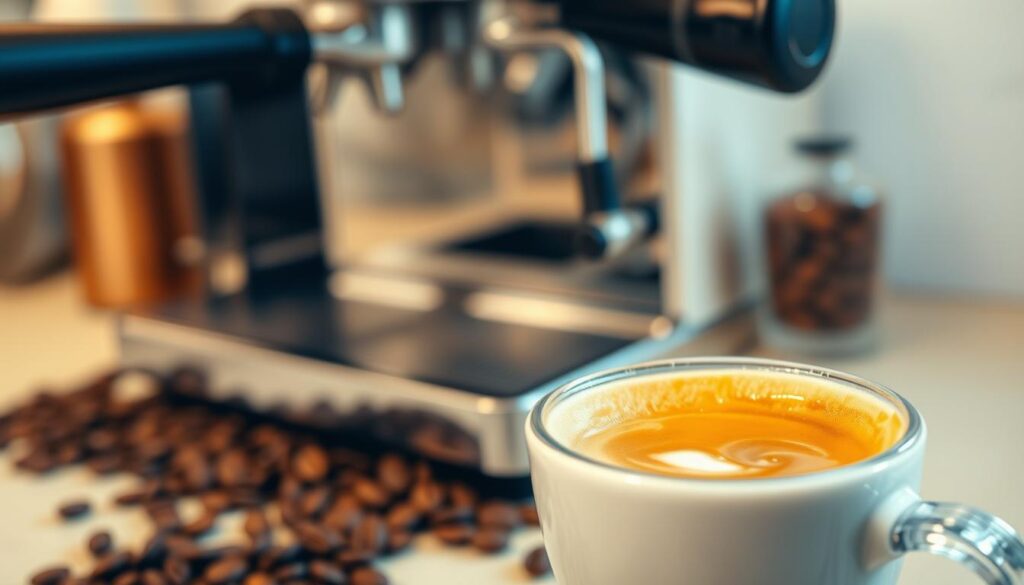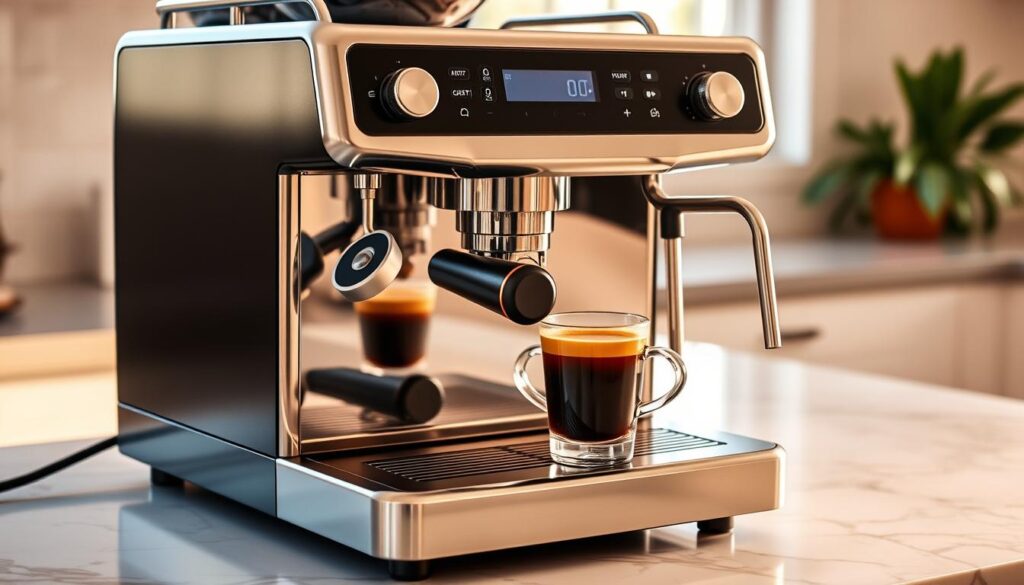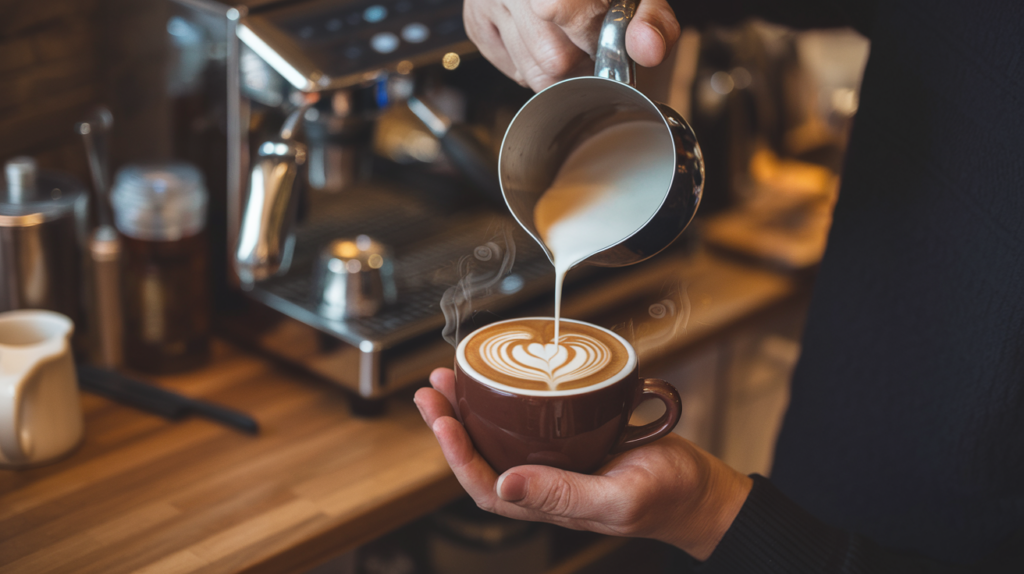This website contains affiliate links. As an Amazon Associate, I earn from qualifying purchases. The content on this website was created with the help of AI.
Mastering espresso shot perfection is an art that can take your coffee to new levels. It’s all about the details, from color and consistency to timing and taste. By paying attention to these, you can enjoy a coffee that truly delights.
Every detail matters in making the perfect espresso. The right color shows it’s been extracted well. The creamy texture means it’s just right, not too thin or thick. And the flavors, balanced perfectly, make it truly exceptional.
By focusing on these aspects and improving your skills, you can make every cup a special moment. For beginners, getting the right equipment is key. Check out the top coffee machines for beginners to make your espresso-making smooth.
The Importance of Espresso Shot Quality
In the world of espresso, the quality of each shot is key to a great coffee experience. Understanding the art and science of espresso brewing is essential. This knowledge comes from knowing the espresso extraction process and the importance of fresh coffee beans.
Understanding Espresso Extraction
The espresso extraction process is complex, needing a balance of time, pressure, and temperature. The best extraction times are between 25 to 30 seconds. This allows for the perfect release of flavors and oils.
During extraction, water pushes through the coffee grounds, causing chemical reactions. These reactions affect the espresso’s depth and richness. Too quick, and it’s sour. Too slow, and it’s bitter.
The Role of Fresh Beans in Quality
Using fresh coffee beans is vital for a top-notch shot. Freshly roasted beans offer a wide range of flavors that stale beans can’t match. They have more aromatic oils and compounds for balanced extraction.
For the best results, look for beans from trusted sources like Coffee Research Institute, Barista Hustle, and Counter Culture Coffee. These suppliers offer the finest brews.
To know when your espresso shot is perfect, understand these key points. The espresso extraction process and fresh coffee beans are crucial. They lead to a remarkable coffee experience.
- First, master the espresso extraction process by focusing on time, pressure, and temperature.
- Second, always choose fresh coffee beans for the richest flavors and aromas.
Signs of Perfect Espresso
For coffee lovers and baristas, knowing the signs of perfect espresso is key. It all starts with looking at the espresso’s visual quality. Several important signs can guide you to the perfect shot.
Visual Indicators
First, check the espresso’s visual quality as it flows from the portafilter. A perfect shot looks like warm honey, flowing steadily into the cup. Its color should be rich, ranging from dark brown to caramel.
- Color and Texture: The espresso should be rich, not too light or watery.
- Flow Rate: The flow should be balanced, neither too fast nor too slow.
The Perfect Crema
The crema on top of your espresso is a key sign of perfection. This golden layer keeps the flavor and aroma in, showing the espresso’s freshness and quality.
- Color: The crema should be warm, hazel to dark brown, showing proper extraction.
- Thickness: It should be dense but not too foamy, sealing in the espresso’s taste.
| Characteristic | Indicator |
|---|---|
| Color | Hazel to dark brown |
| Flow Rate | Steady and consistent |
| Crema Thickness | Dense, sealing in aromas |
| Texture | Honey-like consistency |
How to Evaluate Espresso Taste
Evaluating espresso flavor is all about the senses. You need to pay close attention to the aroma, body, acidity, and aftertaste. Whether you drink coffee often or just sometimes, knowing about espresso taste indicators can make you enjoy a good shot more.
Experts use special methods, like those from the Specialty Coffee Association, to check espresso. Here are the main things to look at:
- Aroma: The first thing you notice. A good aroma means the beans are fresh and of high quality.
- Body: How the espresso feels in your mouth. A great shot should feel thick and smooth.
- Acidity: This adds brightness and depth to the flavor. The right amount of acidity makes the taste better.
- Aftertaste: What you taste after swallowing. A good aftertaste should be nice and last a bit.
Getting good at tasting espresso takes practice and careful attention. Try different beans and brewing methods. Also, visit top coffee shops and use good equipment to learn more about espresso taste indicators.
By improving your tasting skills, you’ll notice and enjoy the unique flavors in each espresso. So, the next time you have an espresso, really take in its rich and complex taste.
Espresso Taste Indicators for Perfection
Making the perfect espresso is all about balance. Knowing what to look for can turn a good shot into an amazing one. It’s all about the taste.
Balanced Flavor Profile
A great espresso has balanced espresso flavors. It should mix sweetness, acidity, and bitterness just right. The sweetness comes from sugars caramelizing, adding a touch without being too much.
Acidity brings a bright, tangy taste that makes the drink pop. But it shouldn’t be sour. Bitterness adds depth and complexity, rounding out the flavors. Together, they create a rich, satisfying drink.
“The interplay of sweetness, acidity, and bitterness in espresso is akin to a symphony—each component playing its part to create a masterful piece.” – Coffee Chemistry
Aromatics and Aftertaste
The aroma of espresso is key to the experience. A top-notch espresso will have espresso aromatic qualities that hint at its flavor. These can be floral, fruity, nutty, or chocolaty, building excitement for the taste.
The perfect espresso aftertaste is also crucial. It should leave a clean, pleasant taste that makes you want more. A good aftertaste shows the espresso’s quality and the skill in making it.
When flavors, aromas, and aftertaste come together, an espresso becomes truly special.
| Element | Description |
|---|---|
| Sweetness | Derived from caramelization, should be noticeable but not dominating. |
| Acidity | Bright and pleasant, enhancing flavor without being sour. |
| Bitterness | Adds depth and complexity, should complement rather than overpower. |
| Aromatics | Floral, fruity, nutty, or chocolaty characteristics that enhance anticipation. |
| Aftertaste | Clean and pleasant lingering flavor, indicating overall quality. |
Key Characteristics of an Ideal Espresso Shot
Espresso lovers always seek the perfect shot. To find it, they focus on volume, temperature, and how long it takes to make. These factors help create a shot that pleases even the pickiest of palates.
The volume of an espresso shot is key. It should be between 1 to 1.5 ounces. This size ensures the flavors of the coffee are balanced.
Temperature is also very important. The ideal brewing temperature is between 195°F and 205°F. This range helps the coffee grounds extract fully, keeping the flavors rich.
Time is another crucial factor in identifying ideal espresso. A good shot takes about 25 to 30 seconds to make. This time is just right for the perfect extraction, avoiding sourness or bitterness.
| Characteristic | Ideal Range |
|---|---|
| Volume | 1 – 1.5 ounces |
| Temperature | 195°F – 205°F |
| Time | 25 – 30 seconds |
These technical details are key, as barista training and espresso makers agree. By knowing these espresso shot characteristics, you can brew the perfect espresso every time.
Troubleshooting Common Espresso Shot Issues
Having trouble with your espresso shot can be really frustrating. But, knowing what causes the problem can help fix it. This part will cover the most common espresso issues and how to solve them, so every shot is just right.
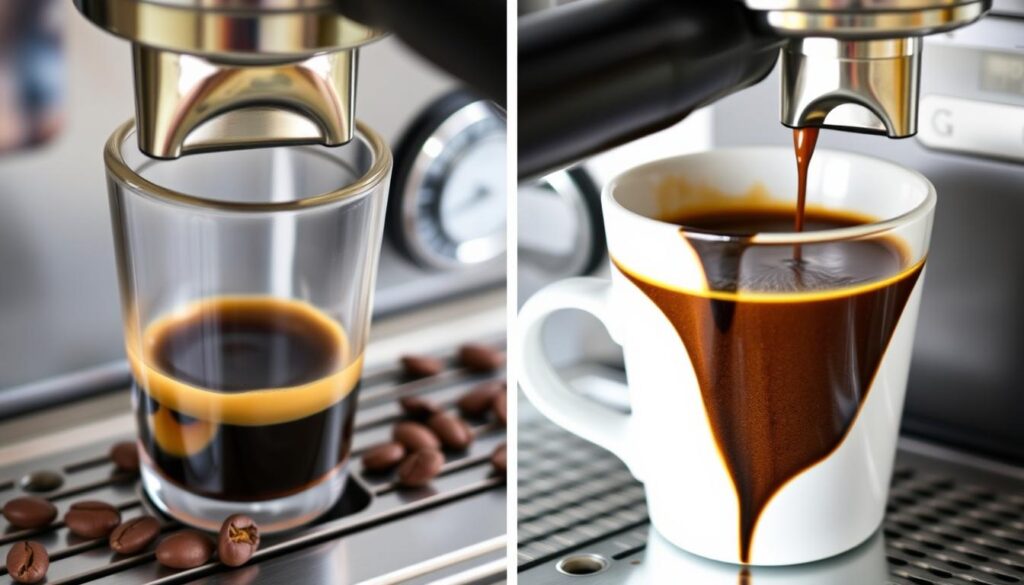
Over-Extraction Problems
Over-extraction makes your espresso taste bitter. It happens for a few reasons:
- Finely ground coffee
- Too much tamping pressure
- Brewing for too long
To fix this, use a slightly coarser grind. Don’t press too hard when tamping. And, make sure the brew time isn’t too long.
Under-Extraction Fixes
Under-extraction makes your espresso taste sour or acidic. It’s often caused by:
- Using a coarse grind
- Not tamping enough
- Brewing for too short a time
To solve under-extraction, use a finer grind. Press harder when tamping. And, brew for a bit longer to get the right extraction.
Here’s a comparative table for over-extraction and under-extraction fixes:
| Issue | Symptoms | Corrections |
|---|---|---|
| Over-Extraction | Bitter taste | Coarser grind, moderate tamping, shorter brew time |
| Under-Extraction | Sour taste | Finer grind, firmer tamping, longer brew time |
By spotting and fixing these common espresso issues, you can solve any espresso shot troubleshooting problem. And, you’ll enjoy a perfectly balanced cup every time.”
Achieving Perfect Espresso at Home
Getting the perfect espresso at home takes hard work and a deep understanding of the craft. By focusing on perfecting espresso extraction, you can make your home brewing as good as a pro’s.
First, get the right equipment. Look for brands like Breville and De’Longhi for great home espresso machines. They offer quality at a good price. Also, get a reliable burr grinder, like the Baratza Encore, for consistent grinds. This is key for perfecting espresso extraction.
Choosing fresh, high-quality beans is also crucial. Roasters like Stumptown and Intelligentsia can make your home espresso brewing better. Use beans that are roasted within two weeks for the best flavor.
To improve your espresso, focus on these brewing techniques:
- Pre-Infusion: Start with a short pre-infusion to soak the coffee grounds evenly.
- Temperature Control: Keep the water between 195-205°F to get the right extraction.
- Extraction Time: Aim for 25-30 seconds for a balanced shot.
- Tamping: Press down evenly while tamping for even extraction.
Lastly, learn from home barista forums and reviews. Talking with others can give you tips and tricks to improve your espresso at home.
| Equipment | Features | Recommended Brands |
|---|---|---|
| Espresso Machine | Consistent temperature, pressure control | Breville, De’Longhi |
| Burr Grinder | Uniform grind size, adjustable settings | Baratza Encore |
| Fresh Beans | Recent roast date, specialty grade | Stumptown, Intelligentsia |
The Role of Equipment in Perfecting Espresso Extraction
Making the perfect espresso shot is about skill and the right tools. Choosing the right equipment can greatly improve your coffee. For home brewing, investing in top-notch machines and grinders can really enhance your coffee experience.
Choosing the Right Espresso Machine
The espresso machine is key in your equipment selection. Look for machines with consistent temperature and pressure control. Favorites among home baristas include the Breville Barista Express and the Rancilio Silvia for their reliability.
Features like a built-in steam wand and programmable settings are important. A durable build is also crucial. A quality home espresso machine ensures a consistent and enjoyable espresso experience.
Importance of Consistent Grinding
A good grinder is essential for consistent coffee grinding. Burr grinders are better than blade grinders because they provide a uniform grind size. Brands like Baratza and Eureka offer great options for home use.
With a quality grinder, you can adjust the grind size for your espresso machine. This leads to consistent results every time.
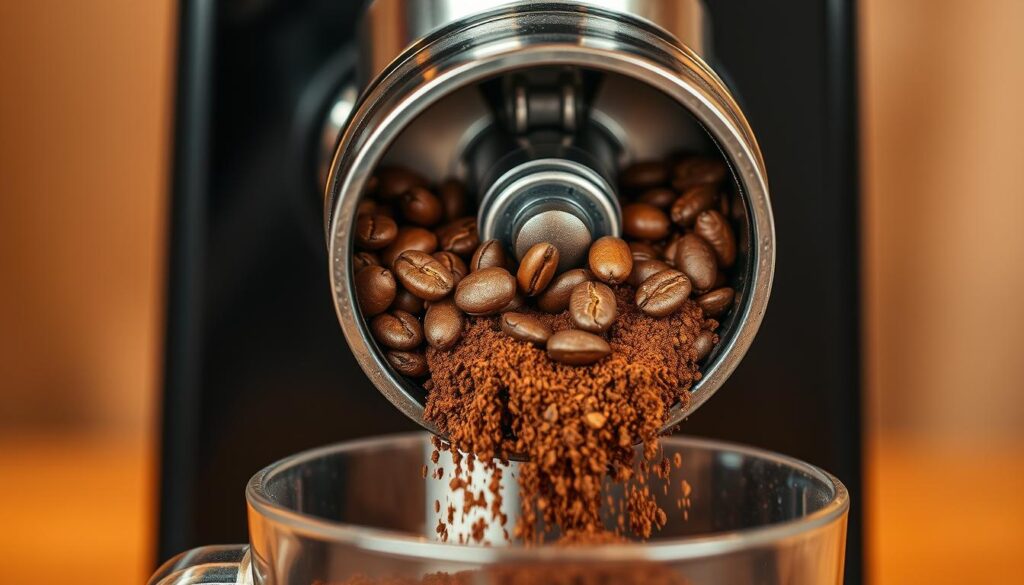
By focusing on the right equipment and consistent grinding, home baristas can improve their espresso shots. Investing in quality tools like home espresso machines and burr grinders is a step towards achieving café-quality espresso at home.
Identifying Ideal Espresso Through Shot Evaluation
Doing a good espresso shot evaluation means looking at it, feeling it, and tasting it. You need to follow rules from barista competitions and SCA scoring sheets. This way, you can tell if the espresso is top-notch.
First, look at the espresso. It should have a thick, golden crema. This crema should look like honey and cover the espresso evenly.
Then, feel the espresso. It should feel smooth and soft in your mouth. It should not be gritty or too oily. This is key for a great espresso.
Lastly, taste the espresso. A perfect shot tastes balanced. It should have sweetness, acidity, and bitterness all working together. The smell should be strong and pleasant, leaving a nice taste after you swallow.
- Perform a visual inspection for uniform, golden crema.
- Evaluate the tactile sensation, aiming for a smooth and velvety texture.
- Conduct a taste test, checking for a balanced flavor profile and aromatic aftertaste.
By following this guide, every espresso shot evaluation will meet the highest quality standards. You’ll enjoy the perfect espresso every time.
How to Tell When Your Espresso Shot is Perfect
Getting the perfect espresso shot needs careful attention and following specific steps. These tips will help you achieve the best espresso and avoid common mistakes.
Steps to Confirm Espresso Quality
- Grind Consistency: Make sure the coffee beans are ground finely and evenly. This is key for good extraction.
- Tamping Pressure: Press down on the coffee grounds evenly when tamping. This ensures a flat coffee bed.
- Extraction Time: Aim for 25 to 30 seconds of extraction. Adjust this based on your taste preferences.
- Crema Appearance: A thick, golden-brown crema that lasts a few minutes is what you’re aiming for.
- Taste Test: Your espresso should taste balanced, rich, and have a nice aftertaste.
For more detailed tips, check out how we pull the perfect shot of espresso at Muddy’s.
Common Mistakes to Avoid
- Incorrect Grind Size: The wrong grind size can mess up the flavor and extraction.
- Inconsistent Tamping: Uneven tamping can cause channeling, leading to under-extraction.
- Poor Quality Beans: Use fresh, high-quality beans to avoid a stale or bitter taste.
- Ignoring Equipment Calibration: Regularly check and calibrate your espresso machine and grinder for best results.
- Overlooked Extraction Time: Wrong extraction times can make the espresso sour or bitter.
Avoiding these mistakes will greatly improve your chances of making a perfect espresso shot. Espresso making is a mix of science and skill, as shown by experts like Stephen at Muddy’s. By following these tips and fixing common errors, you’ll be making perfect espresso shots every time.
Conclusion
Learning to make perfect espresso is a journey and a goal. This article covered the details of making great espresso shots. It talked about everything from using fresh beans to knowing when a shot is just right.
Every step in making espresso needs careful attention. This includes spotting the perfect crema and tasting the shot. It also means fixing common problems.
Practice and patience are key. Becoming a skilled barista takes time and effort. It’s a journey of learning and trying new things.
Success stories from coffee lovers and professional baristas offer great advice. They share their experiences and tips. This helps you grow and stay motivated.
Perfect espresso is about knowing your craft and loving coffee. Keep trying new things and enjoy the journey. It’s the little victories that make it all worth it.
Keep working on your skills, and you’ll soon make espresso that’s just right. Every cup will be a step closer to perfection.
This website contains affiliate links. As an Amazon Associate, I earn from qualifying purchases. The content on this website was created with the help of AI.

